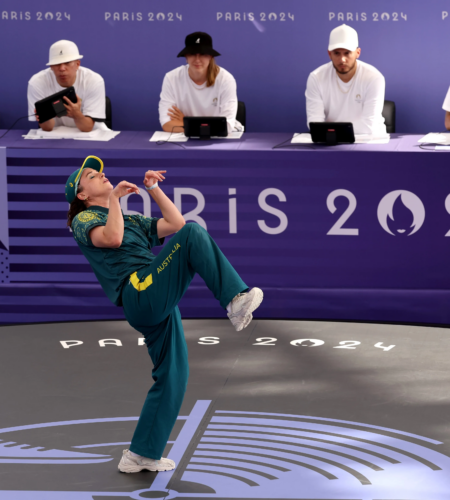(Image Credit: Getty Images)
The 2024 Paris Olympics offered a dazzling array of unforgettable moments: Simone Biles’ triumphant return, Noah Lyles’ nail-biting victory in the 100m, and a Turkish shooter whose unconventional stance left spectators in awe. Yet, amidst these high-flying feats, one performance has sparked a debate that blends viral fame with cultural critique—the Australian breakdancer Raygun’s now-infamous “Kangaroo Dance.”
Rachael Gunn, a 36-year-old Australian professor who goes by “Raygun” in the breakdancing world, found herself at the center of a viral sensation for all the wrong reasons. Her performance at the Olympics quickly became legendary, not for its prowess but its unique style and somewhat lackluster execution. The internet erupted as Gunn took to the dance floor, and her unconventional moves, which included awkward shuffles and kangaroo-inspired hops, stood in stark contrast to the high-energy routines of her competitors. The spectacle of her dance, which playfully incorporated elements reminiscent of Australia’s national animal, became a viral sensation largely due to its perceived awkwardness and novelty.
Artistic Intent vs. Audience Expectations
While Raygun’s routine was intended to be a distinctive expression of her individuality, the reaction was far from universally positive. The dance was mocked and humorously replicated on social media, with enthusiasts sharing videos of their attempts to imitate the unconventional moves. Instead of being celebrated, Raygun’s performance was a source of amusement and derision, highlighting a clash between individual expression and audience expectations.
Defending the Artistic Vision
In response to the criticism, Raygun defended her artistic choices during a news conference with ESPN. She emphasized that her goal was to introduce something new and creative to the competition. “What I wanted to do was come out here and do something new and different and creative—that’s my strength, my creativity,” said Gunn. “I was never going to beat these girls on what they do best, the dynamic and the power moves, so I wanted to move differently, be artistic and creative because how many chances do you get that in a lifetime to do that on an international stage?”
Australia’s chief de mission, Anna Meares, also stepped in to defend Gunn, expressing her disappointment with the online backlash. “I love Rachael … I think that what has occurred on social media with trolls and keyboard warriors, and taking those comments and giving them airtime, has been really disappointing,” Meares said.
Allegations and Accusations
The controversy surrounding Raygun’s performance took a more serious turn when critics began to question the integrity of the Olympic selection process. One self-described “Someone Who Hates Corruption” launched a Change.org petition, now boasting over 57,000 signatures, accusing Raygun of manipulating the selection process. The petition alleged that Gunn had established her own governing body for breakdancing and secured her position through questionable means, including undue influence from her husband, who also served as the Olympic team’s coach. The petition called for a public apology from Gunn and Australian Olympic Committee President Anna Meares, as well as a full investigation into the selection process and an audit of Gunn’s business dealings.
The Broader Cultural Context

These allegations have fueled accusations of favoritism and unethical behavior, casting a shadow over what was intended to be a celebration of athletic artistry. The claims suggest a breach of the Olympic spirit, which emphasizes transparency and fairness. However, despite the fervent petitions and public outcry, there is no substantial evidence supporting these accusations.
The uproar reflects a broader cultural phenomenon where viral sensations are scrutinized not just for their content, but for their perceived impact on established norms and values. The backlash against Raygun’s performance illustrates how the intersection of viral fame and cultural expectations can transform a moment of personal expression into a battleground of public opinion.


